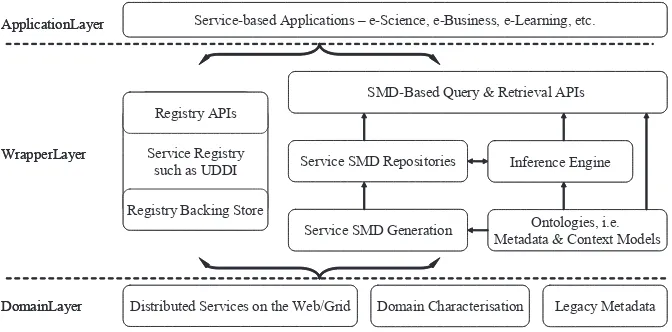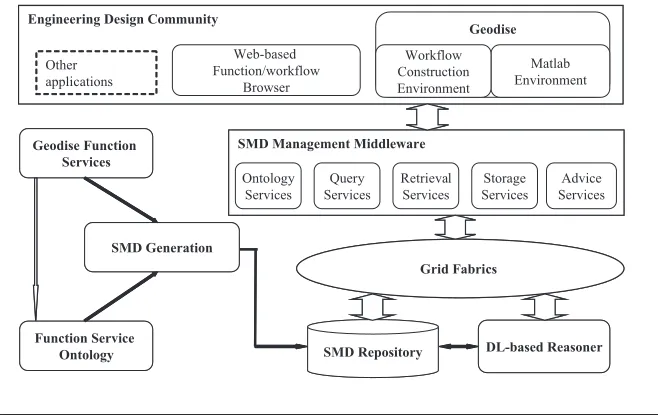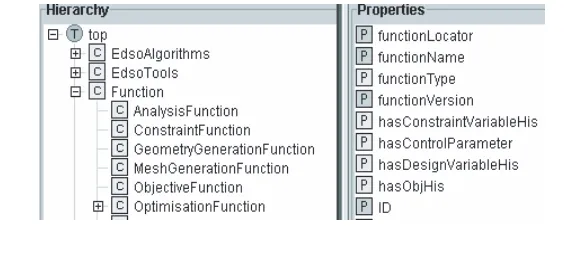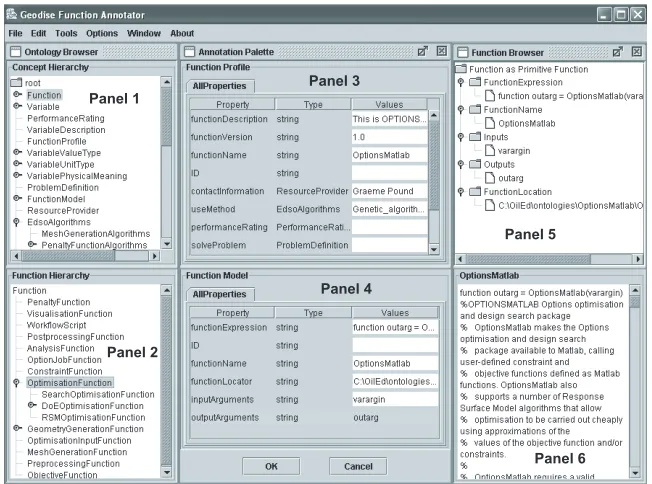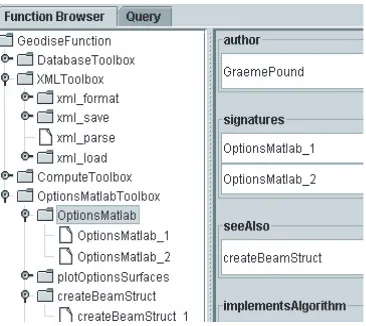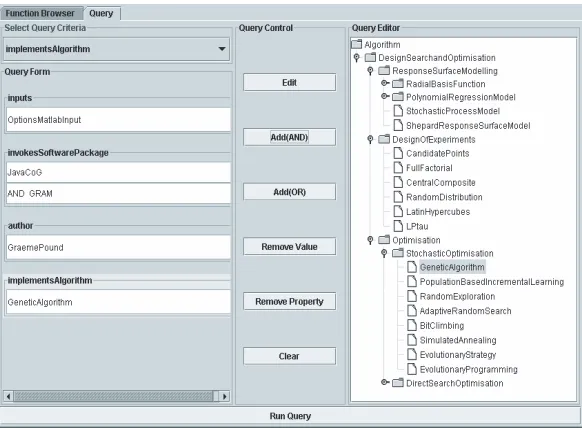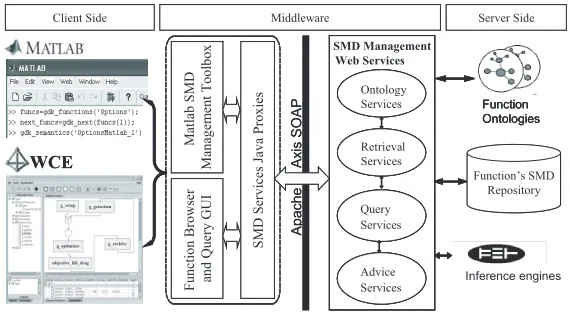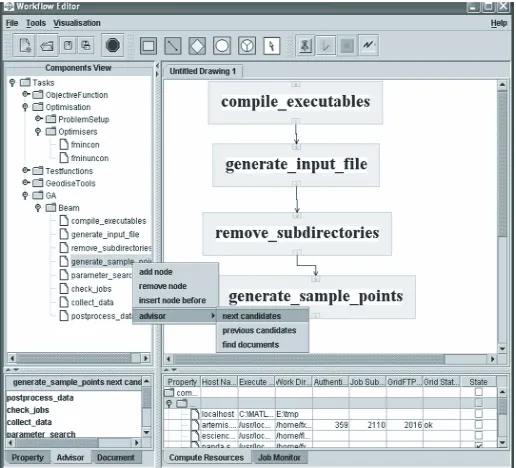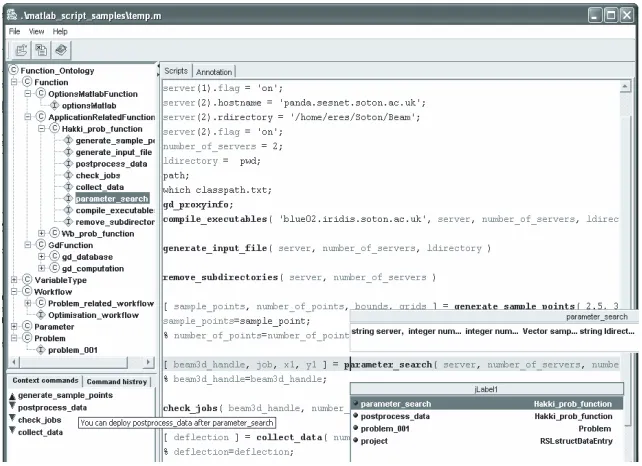ABSTRACT
Web/Grid services’ metadata and semantics are becoming increasing important for service sharing and effective reuse. In this paper we present a generic framework for engineering and managing services’ Semantic Metadata (SMD) with the ultimate purpose of facilitating interoperability, automation, and knowledgeable reuse of services for problem solving. The framework addresses fundamental issues, approaches, and tools for the whole lifecycle of SMD management, in other words, those of acquiring, modeling, representing, publishing, and reusing services’ SMD. It adopts ontologies and the Semantic Web technologies as the enabling technologies by which services’ metadata are semantically enriched and made interoperable, understandable, and ac-cessible on the Web/Grid for both humans and machines. In particular, mechanisms are proposed to make use of service SMD for service discovery and composition. The paper also describes a service SMD management system in the context of the UK e-Science project GEODISE. A suite of tools are developed, which forms the core of the SMD management infrastructure. We demonstrate the added value of the use of SMD through the integration of SMD management with GEODISE application systems.
Keywords: engineering design; knowledge management; metadata; ontology; Semantic Grid; Semantic Web; Web services
INTRODUCTION
The essence of Grid computing (Foster & Kesselman 2004) is the sharing and reuse of distributed heterogeneous resources for coordinated problem solving. Its success relies on the effective discovery, seamless aggrega-tion and effective use of the “right” services
for the “right” problem. Metadata is data that provide extra information about other data. For example, a photo can be described using the following metadata: <dateTaken> 12/09/2003 </dateTaken>, <placeTaken> seminar room </placeTaken> and <whatAbout> GEODISE project meeting </whatAbout>. Metadata is be-coming increasingly critical in Web/Grid
com-Managing Semantic Metadata
for Web Grid Services
L. Chen, University of Ulster, UK N. R. Shadbolt, University of Southampton, UK
puting because human users as well as software agents increasingly rely on metadata for service discovery, reuse, and expertise sharing.
Metadata exist at all levels of the Grid, ranging from low-level repositories of resource handles to upper-level application-related services. At the time of writing, the metadata of low-level hardware-related Grid services is stored and managed by core Grid services such as Globus MDS (www.globus.org/mds) and RGMA (www.r-gma.org). In the Open Grid Service Architecture (OGSA) (Foster, Kesselman, Nick, & Tuecke, 2002) applica-tion-level resources are wrapped as Web or Grid Services, and services’ metadata are associated with Web/Grid services, which are described in WSDL files (www.w3.org/TR/wsdl12), and published and stored in UDDI repositories (www.uddi.org).
The way that current service-oriented infrastructure handles and manages services’ metadata is not adequate and effective for metadata to help services discovery and knowledge sharing. First, there is no enough metadata about Web/Grid services. Services, in particular, legacy resources, are developed by service providers for their own use, without realising the role and importance of metadata this naturally leads to the lack of descriptive information for services. Second, metadata are unstructured. Web/Grid services are diverse; the types of metadata required for describing ser-vices in e-Science (Hey & Trefethen, 2003) vary greatly between individuals, organisations, and scientific communities. The use of different ter-minologies and the adoption of various metadata models such as using comments or annotations as metadata are inevitable. Unsurprisingly, this causes the problem of mutual understanding and service interoperability. Third, metadata lack semantics. XML- (www.w3.org/XML) based metadata modeling and representation as in WSDL and UDDI are incapable of capturing genuine semantics, relationships, or constraints. There are no problems for humans to understand XML-based metadata as described in the above photo example because we know the meaning of these English words. The question is: “can
machines understand and consume them?” so that they can perform automated and automatic processing with regards to the use of Web/Grid services. Clearly without further assumptions, the answer will be no. Fourth, there are no dedicated metadata storage and associated query and reasoning facilities. UDDI is not supposed to deal with large amount of metadata. While it is possible to incorporate rich metadata into UDDI repositories, UDDI itself does not provide scalable storage mechanisms and rich capabili-ties for manipulating metadata, such as query and reasoning against metadata.
The Semantic Web (Berners-Lee, Hendler, & Lassila, 2001) and Semantic Grid (De Roure, Jennings, & Shadbolt, 2003; Zhuge, 2005) are extensions of the current Web/Grid in which information and services are given well-defined meaning, better enabling computers and people to work in cooperation. We believe that the first step towards the Semantic Web/Grid is to make the Web/Grid full of rich SMD, in other words, metadata with semantics. To achieve this objective, we argue that an integrated frame-work for SMD modelling and management is required so that service’s metadata are flexible and extensible, and metadata generated in such a way have explicit, conceptually consistent meaning. This framework ought to exploit knowledge engineering techniques in advanced knowledge technologies (Zhuge, 2005) (Goble, De Roure, Shadbolt, & Fernandes, 2004) (www. aktors.org/akt), the emerging infrastructure in the Semantic Web and Web/Grid services technologies (www.w3.org/2002/ws/) (www. globus.org/wsrf) communities in order to work with heterogeneous distributed services across dynamic virtual organisations.
the complete life cycle of SMD management based on the state of the art of the research on the Semantic Web, Web Services and the Grid. Thirdly a reference implementation for the framework is developed and deployed in the context of Grid-Enabled Optimisation and Design Search in Engineering (GEODISE) (www.geodise.org). The implementation not only verifies our approach but also provides an infrastructure for applying this approach to real world applications. We demonstrate the benefits of using SMD for problem solving.
The paper first introduces the framework for SMD management, which include detailed analyses and discussions for each constituent component regarding its functionality and realisation approaches. Second we describe the design and implementation rationale of the SMD management framework in the context of GEODISE. Then we present the deployment of the SMD management system and demonstrate its usage and benefits in service composition. Experience and lessons learnt from the research are also discussed. Following this we review related work and point out our contributions. Finally we conclude the paper by discussing future extensions and improvements.
A SYSTEMATIC FRAMEWORK
FOR ENGINEERING AND
MANAGING SERVICE’S SMD
Semantic metadata refers to the meta-data that are formally modeled based on their context, thus giving them meaning. Service SMD is actually a type of knowledge about the service’s general characteristics, interfaces and execution details. By this view, we argue that SMD management should have its own lifecycle, namely those of acquiring, modeling, representing, publishing, and reusing a service’s SMD. While traditional knowledge manage-ment technologies (Schreiber, Akkermans, Anjewierden, Hoog, & Shadbolt, 1999), which provide methods, templates, protocols, and tools to support the lifecycle of knowledge, are available, they are not designed for distributed knowledge management. For example, most of knowledge models, templates, and
representa-tions for standalone applicarepresenta-tions cannot be recognised, shared, and reused by Web/Grid users and applications.
Inspired by the latest research results on ontologies and the Semantic Web, we conceive an ontology-centric approach to SMD manage-ment. The key features of the approach are as follows: Firstly, ontologies are used for meta-data and context modeling, thus help towards interoperability and machine understandability. Secondly, knowledge acquisition, i.e., service metadata collection and semantics tagging, is carried out semi-automatically through a formal knowledge binding process—also known as semantic annotation. Thirdly, Web ontology languages are used for SMD knowledge rep-resentation, thus enabling knowledge sharing and effective reuse.
Figure 1 shows the SMD management framework, which specifies key components and their interactions. In this framework we abstract away low-level Web/Grid compute fabrics and focus on application-level services and their metadata management. We take a broad view with regards to Web/Grid service type and representations, in other words, services could be Web/Grid services and/or any other forms of computational algorithms and functions. As can be seen in the figure, the framework consists of DomainLayer, ApplicationLayer and Wrap-perLayer. The DomainLayer contains domain-specific services, knowledge, and metadata. The ApplicationLayer refers to various systems that make use of domain services and knowledge for problem solving. In standalone computing environment, the ApplicationLayer will be di-rectly on top of DomainLayer and application systems will only use local domain services for accomplishing tasks. To enable distributed applications to access and use distributed ser-vices on the Grid the WrapperLayer is needed to facilitate service wrapping, publishing, discovery, and reuse.
registries such as a service registry and service indexes. Service consumers discover required services from public registries in terms of key words and/or functionality signature. The lack of rich metadata, in particular their explicit semantics, makes current Web/Grid applica-tions usually involve huge amount of front end preparations such as human interpretation and manual configuration.
The right module of the WrapperLayer shows the anatomy of SMD management sys-tem. It is intended to replace present service registry with SMD-based service management system with its ultimate goal of creating a SMD rich Web/Grid environment. The added values of SMD management are the promotion of service interoperability, machine understand-ability, and automation. Detailed descriptions about functionality, methods and techniques for each component, and their limitations and advantages are described below.
Ontologies:
Metadata and Context Modeling
This component intends to capture all metadata of Web/Grid services and the concepts related to domain in which these services oper-ate. It further models these metadata, concepts, and their relations in a structure using commonly
agreed terms. The purpose is to abstract the ontological entities of metadata and put them in context, thus giving them meaning.
Metadata need to be interpreted with re-spect to a context, in other words, the domain the metadata are about. The interpretation is actually the assignment of meaning to metadata symbols in terms of domain concepts and/or theories. As the Web/Grid is an open world environment encompassing a wide variety of fields, communities and areas, a service’s meta-data may be given different meaning dependent on the users’ understanding and background knowledge about the service. Such multiple and even ambiguous interpretations will also prevent machines and software agents from automatically processing metadata because they do not know in which domain the meta-data should be interpreted. Therefore, a formal context modeling is required.
In knowledge representation, context modeling amounts to creating an abstract, simplified view of the world that we wish to represent for some purposes. Given that context is used for metadata interpretation in our case, metadata modeling will go hand in hand with context modeling.
Our framework uses ontologies to perform metadata and context modeling in which enti-Figure 1. The generic SMD management framework
Distributed Services on the Web/Grid Domain Characterisation Service SMD Repositories
Service SMD Generation Metadata & Context ModelsOntologies, i.e. Service Registry
such as UDDI
SMD-Based Query & Retrieval APIs
Inference Engine
Legacy Metadata DomainLayer
WrapperLayer
Service-based Applications – e-Science, e-Business, e-Learning, etc. ApplicationLayer
Registry APIs
Registry Backing Store
Distributed Services on the Web/Grid Domain Characterisation Service SMD Repositories
Service SMD Generation Metadata & Context ModelsOntologies, i.e. Service Registry
such as UDDI
SMD-Based Query & Retrieval APIs
Inference Engine
Legacy Metadata DomainLayer
WrapperLayer
Service-based Applications – e-Science, e-Business, e-Learning, etc. ApplicationLayer
Registry APIs
[image:4.522.104.440.104.270.2]ties such as services will be conceptualised as ontological concepts and an entity’s metadata will be conceptualised as its properties. For instance, in the above photo example, the photo will be modeled as an ontological concept and metadata such as dateTaken, placeTaken and whatAbout will be modeled as the properties of the photo concept. Context modeling will conceptualise all other entities related to the concerned entity and establish relations among them via concepts’ properties. Overall context modeling will create a self-contained ontology in which metadata can be interpreted unambigu-ously by both humans and machines.
Ontology-based metadata and context modeling provides a common communication language for Web/Grid service providers and consumers. It is normal that service providers and/or consumers in different virtual organisa-tions refer to same things with different terms (and/or different things with same terms). For instance, a photo may be described using the following set of metadata: <dateTaken>9:00am, 12/09/2003</dateTaken>, <venue>seminar room</venue> and <content> GEODISE proj-ect meeting</content>. These metadata are dif-ferent from those used in the previous example. This means that a person who adopts this set of metadata for photo publishing will be not able to discover photos published in terms of the previous metadata and vice versa. The use of ontologies will bridge up the gap by providing a commonly agreed terms, thus enhancing the interoperability. It also allows for flexibility and adaptation to accommodate diverse metadata and future changes within the field.
Service SMD Generation
Ontology-based metadata models are conceptual templates, in other words, knowl-edge-preserving structures. To generate SMD, it is necessary to bind metadata models with the concrete information of the concerned services. This component consists of two tasks—meta-data collection and metatasks—meta-data instantiation with metadata models (ontologies). In view of the nature of heterogeneity, distribution and the dynamics of Web/Grid environment, SMD
generation pose a great challenge for SMD management.
Two approaches are identified for captur-ing services’ metadata: the human-centered approach and information extraction based approach. In the first approach, a person (either a service provider or a domain experts or a knowledge engineer) analyses service domain, obtains all metadata values and prepares them in accordance with the metadata model. This approach requires that the person should have domain background knowledge. The latter approach is to extract metadata values using information extraction techniques. It tries to acquire metadata automatically by parsing and recognising designated entities and their val-ues. The problems with this approach are that different service providers may use different terminology for their services. An information extraction algorithm that works for one domain may not work for others. Furthermore, some services, in particular those legacy services, may not have enough information.
SMD is generated through metadata in-stantiation and semantic enrichment. Metadata instantiation is to assign values to metadata. Se-mantic enrichment is to establish links between the services (concepts), metadata (properties), and metadata assignments (fillers). By following ontological links metadata and their assignment can be explicitly defined in terms of ontological concepts, properties, values and relations. These links allow both humans and machines to track down the exact meaning of metadata and their assignments based on the ontology—context model. This guarantees metadata can be inter-preted unambiguously.
on a service’s domain and its characteristics. It is highly likely to carry out automatic metadata collection and binding with services that have well-structured data and/or well-represented interfaces. In reality it proves hard to generate SMD automatically because the lack of stan-dards and conventions for the terminology and representation of distributed Web/Grid services has made automatic IE very hard. Therefore, in general a semi-automatic approach involving both IE tools and human interactions is more realistic. In such approach domain-oriented dedicated IE tools are developed to perform information extraction to obtain as many metadata values as possible. The SMD creator will manually collect and bind the missing metadata.
Service SMD Repositories
Service SMD repositories component is responsible for service SMD representation and storage, which are described below.
Service SMD Representation
SMD representation needs to fulfill several requirements. First it should have appropri-ate expressive capabilities, thus being able to model and convey all explicit meaning of metadata without any ambiguity and fidelity loss. Second it should be easily distributed and accessed on the Web/Grid so that as many Web/Grid users as possible can get hold on it. Third SMD representation should allow for high degree interoperability and machine understandability in order to facilitate SMD processing and semantic consumption for end users’ applications.
Many languages have been designed to express the ontology and semantic information. Among them, the most recent is the Web On-tology Language (OWL) (www.w3.org/2004/ OWL), which has evolved from RDF (www. w3.org/RDF/) and DAML+OIL to provide more expressive power. RDF is a graph model (or sets of triple statements) which is designed for describing and searching services on the Web. DAML+OIL (www.daml.org) is a schema lan-guage that adds constraints on properties to assist
machine reasoning. For example when “daml: TransitiveProperty” is added as a constraint on the property “P1:older_than” of a RDF model, if we have A1:P1:A2 and A2:P1:A3, then A1: P1:A3 can be inferred. This is useful for rea-soning and inferring new knowledge that has not been directly stated. DAML+OIL also uses subProperty to describe relationship at different granularities. OWL is built on DAML+OIL with additional constraints such as “sameAs”, “cardinality”, and so forth, for more expressive power. Both DAML+OIL and OWL are based on the knowledge representation formalism of Description Logic (DL), which gives OWL a solid foundation on which semantics can be explicitly expressed and reasoned.
RDF is well established in the Semantic Web communities as a knowledge representa-tion language. There exist various open source tools, APIs and diversity of RDF repositories for RDF applications. OWL has recently become W3C standard. It also provides three increas-ingly expressive sublanguages designed for use by specific communities of implementers and users. With many open source tools and APIs be-ing developed, OWL is gettbe-ing its currency.
Which language to use for SMD represen-tation is actually a question of choice, depending on application characteristics, users’ preferences and the way SMD is used. For applications that involve large amount of ontological concepts, thus requiring consistency check and classifi-cation OWL might be a better choice. OWL is also appropriate for applications that need description-logic-based reasoning.
Service SMD Storage
using different knowledge representation for-malisms such as RDF and OWL.
There are three different mechanisms to store a service’s SMD. Firstly it can be embedded into the original service as a set of descriptions. Some annotation tools such as the OntoMat-annotizer (annotation.semanticweb. org/ontomat/index.html) in the Semantic Web community use this mechanism to attach seman-tic descriptions to web pages. Secondly, SMD can be saved in a separate storage in the same location as the service is stored. A local refer-ence link will establish the relationship between a service and its SMD. Thirdly SMD can be archived in distributed knowledge repositories separate from services. Globus MDS and Web Service registry such as UDDI have adopted this approach to archive metadata.
As we can not attach text into non-text files or documents, the first mechanism will not apply to services that are modeled and delivered as binary such as executables. Another shortcom-ing is that the overall size of service plus its SMD may become unmanageable in a service registry. It could also incur extra processing costs because both services and their SMD will be accessed and loaded no matter which one is actually required. The second mechanism is straightforward. However, as there are service registries for services and no registries for ser-vices’ SMD, to access a service’s SMD needs to first find the service from a service registry. This will not serve the purpose of SMD as a mean for service discovery as discussed previ-ously. In the context of Web/Grid computing it is supposed that services are owned by and geographically located in dynamic virtual or-ganisations. These services should be published with explicit expressive descriptions exposing as much information as possible, so that they can be discovered, shared, and reused. From this perspective the third approach, in other words, archiving SMD in a (or several dis-tributed) central knowledge repository, seems ideal for realising Web/Grid vision via SMD management. Such knowledge repository can also serve as a registry service similar to the UDDI registry but with rich SMD.
A critical issue in creating SMD reposito-ries operating on the Web/Grid is scalability with regards to the storage, retrieval and reasoning of SMD entities. Real world Web/Grid appli-cations usually involve dozens of ontologies, which may consist of thousands of concepts and hundreds of properties, and large numbers of semantic instances. For example, in AKT project (www.aktors.org), the hyphen.info (www.hyphen.info) dataset consists of around five million RDF triples when serialised, and is expected to grow to several tens of millions if fully populated. The base design scale of the knowledge repository is set to be the ability to handle at least 20 million triples and 5000 classes and properties. In GONG project (gong. man.ac.uk/) researchers have built a semantic knowledge repository that consists of a gene ontology of 50,000 concepts and up to 650,000 individuals. While existing techniques for ter-minological reasoning (i.e., reasoning about the concepts in an ontology) seem able to cope with real-world ontologies (Horrocks, Sattler, & Tobies, 1999; Haarslev & Möller, 2001), it is not clear if existing techniques for assertion reasoning (i.e., reasoning about the individu-als in an ontology) will be able to cope with realistic sets of SMD. This difficulty arises not so much from the computational complexity of assertion reasoning, but from the fact that the number of individuals (e.g., SMD) might be extremely large.
these systems is to use database technology for SMD instance indexing and search optimisa-tion, and semantic inference mechanisms for the classification of ontological concepts. By replacing reasoning with SMD instances with reasoning with concepts and optimised database search, the retrieval and query performance can be significantly improved.
While further extensions and formal experiments and evaluations are needed for SMD knowledge base technologies, neverthe-less these systems, in particular, the 3Store and Instance Store, provide a starting point for SMD management. Once again the development and/ or the selection of SMD repository technology would depend on the nature of the application and the characteristics of the KB.
Inference Engine
Inference Engine provides reasoning capabilities for service SMD management system. It has two main usages: first an infer-ence engine can be used to help construct a large ontology by performing such actions as subsumption, classification, concept consistency check, and more; second, to discover a specific service in terms of user query criteria an inference engine is needed to reason against the SMD repositories.
There are different ontological reasoning engines. For instance, the FaCT reasoner (Hor-rocks et al., 1999) can perform terminological reasoning; the RACER reasoner can perform in-stance reasoning. Requirements for a reasoning engine and its inference capability are closely related to the SMD representation and storage as discussed in Service SMD Storage, it is also pertinent to the SMD use in applications.
SMD-Based Query and Retrieval APIs
Once service SMD repositories are popu-lated with SMD, Web/Grid service consumers can make use of the semantic information for many purposes. This component is responsible for providing semantic information consump-tion mechanisms and tools to facilitate the use of service SMD. General speaking, SMD can
used in the following ways: Firstly consumers can navigate services in the repository in terms of SMD. Services and metadata are classified into different categories when they are formally modeled using ontologies. By referencing the associated ontology users can obtain all services under a specific service category (a concept and/ or a property) and their SMD. These services can be presented in a hierarchical structure that shows their inter-relations and also facilitates selection.
Secondly service consumers can exploit SMD for service discovery. The above func-tionality, otherwise known as service browsing, is desirable but may not be practically realistic when the size of SMD instances grows to thou-sands or millions. Semantics-based search is different from traditional keyword-based search mechanism in that service matching is based on meaning rather than signatures. For example, by specifying a set of metadata and value pairs, DL-based reasoner can discover a number of services that have these metadata. This not only increases the accuracy of service discovery, enhances interoperability, but most importantly, enables automated machine processing.
Depending on the richness of knowledge captured through metadata modeling, SMD can be exploited to different extent for application specific purposes. An example is semantics-based recommender systems for service com-position and aggregation. Service can only be joined together to form a valid workflow when their interface semantics matches each other, in other words, one service’s inputs/outputs are semantically compatible with another service’s outputs/inputs. Based on the semantic matching of service interface a recommender system can suggest all services that fit into the workflow at a specific point during a workflow construction process. The recommendation can also be given in service level for service configuration such as what are the types and default values of a variable, what and where the alternative similar functions are and so on.
how much knowledge the SMD holds. The more knowledge in the SMD, there will be the more SMD usage in Web/Grid applications. The more SMD are available on the Web/Grid, the closer it is for the Web/Grid to move to the so-called Semantic Web/Grid. To facilitate Web/Grid ser-vice consumers to access and retrieve serser-vices in terms of SMD, APIs and tools are needed. This will be discussed in details in the context of GEODISE.
SMD MANAGEMENT
IN GEODISE
Grid-enabled optimisation and design search in engineering (GEODISE) is one of the UK e-Science pilot projects. It is intended to enable engineers to carry out Engineering Design Search and Optimisation (EDSO) by seamless access to a state-of-the-art collection of optimisation and search tools, geometry model-ing and meshmodel-ing packages, analysis codes and distributed computing and data services on the Grid. Extensive analysis of user requirements and application scenarios has revealed that the key issues to achieving GEODISE objectives are (1) how to add rich metadata to GEODISE services, (2) how to semantically enrich them,
and (3) how to allow sophisticated reasoning and query capabilities over them. To this end, we have adopted our framework for SMD management in GEODISE.
GEODISE SMD Management System
EDSO has been practiced for decades, and it has accumulated huge amounts of expertise and algorithms in research institutions and com-mercial enterprises in various formats. Based on survey results of current EDSO practices, GEODISE has decided to use Matlab, a widely adopted engineering package in academia and industry, as its problem solving environment (Eres et al., 2005). The main resource format in Matlab is function scripts—a type of high-level computation programs that can accomplish various EDSO tasks by execution in Matlab environment. This means that application level services in GEODISE are Matlab functions.
[image:9.522.93.422.468.676.2]Figure 2 shows the function SMD man-agement system in GEODISE. The system implements the framework for SMD manage-ment and focuses on a domain specific type of service, in other words, Matlab functions. A key feature of the system is that it adopts a service-oriented approach to distributed SMD
Figure 2. Function service SMD management system in GEODISE
Geodise Function Services
Function Service Ontology
SMD Generation
SMD Management Middleware
Ontology
Services ServicesQuery ServicesAdvice
Engineering Design Community
Web-based Function/workflow
Browser
Geodise
Matlab Environment Workflow
Construction Environment Other
applications
SMD Repository
Grid Fabrics
DL-based Reasoner
Retrieval
Services ServicesStorage
Geodise Function Services
Function Service Ontology
SMD Generation
SMD Management Middleware
Ontology
Services ServicesQuery ServicesAdvice
Engineering Design Community
Web-based Function/workflow
Browser
Geodise
Matlab Environment Workflow
Construction Environment Other
applications
SMD Repository
Grid Fabrics
DL-based Reasoner
Retrieval
management. It implements all activities related to SMD consumption and supply as knowledge Web Services. This approach has two main advantages. Firstly, it fits naturally into the service-based Grid infrastructure, thus easy and straightforward to be integrated into pres-ent Grid infrastructure. Secondly, it provides a common mechanism for Grid users to publish, retrieve and search services’ SMD, thus facilitat-ing Grid service sharfacilitat-ing and reuse.
In the following, we briefly describe the design rationale and implementation details of each component of GEODISE SMD manage-ment system; we also discuss the lessons learnt from the work.
GEODISE Function Ontology
The design rationale of GEODISE func-tion ontology is two fold. First it intends to provide formal metadata models so that func-tions can be described using these commonly agreed models and terms. Second it aims to provide formal context models so that metadata can be unambiguously interpreted.
Ontology development is a knowledge modeling process. In accordance with the Com-monKADS methodology, a number of activities should be done before knowledge models can be built. Following these guidelines, in GEODISE we first carry out domain analysis to identify application scenarios and knowledge intensive points. Second we conduct initial knowledge elicitation and technology survey. Based on results from these activities, we finalise the areas
we shall provide knowledge support, identify knowledge application scenarios, and propose initial knowledge system components. Then we concentrate on knowledge acquisition and modeling, i.e., ontology development. More details can be found in Chen et al. (2002).
We build a domain ontology, which cov-ers the fundamental concepts and properties in EDSO, including variable type, unit types, parameter meaning and algorithm classifica-tion, and a function ontology, which is based on function classification and categorisation, function interface analysis (input/output model-ing), and terminology extraction. The function ontology is based on the OWL-S (www.daml. org/services/) ontology in which we use function profiles to describe function metadata. Semantic descriptions are generated when linking service metadata and interface (inputs/outputs) with underlying EDSO domain concepts.
Figure 3 shows GEODISE function ontol-ogy. The left hand panel displays the hierar-chical structure of the EDSO function-related concepts. The right hand panel lists metadata for Matlab functions.
It is worth pointing out that metadata mod-eling is not a separate standalone activity but closely related to overall application objectives, application scenarios and potential knowledge usage. Initial domain analysis, scenario develop-ment, identification of appropriate knowledge sources and technology bottlenecks are critical for work at later stages. The lesson we get is to get domain experts, application
[image:10.522.124.406.545.675.2]ers, knowledge engineers, knowledge system developers, and end users on board as earlier as possible. Comments, opinions and feedback from different stakeholders are valuable to come up a feasible working plan and drive the project into the right directions.
Generating Function Services’ SMD
In GEODISE, services are Matlab functions, which are written following some conventions. For example, a Matlab function script always starts with the output arguments followed by function signature and then the input arguments; there are also layout rules in the structure of a function script body. Therefore, information extraction and pattern recognition techniques can be applied to Matlab function scripts for automatic metadata extraction. While it is impossible to obtain all information required because not all function providers fol-low the conventions, nevertheless the ability to be able to extract information from functions
will significantly reduce the workload of SMD generation.
We have developed a tool, called Function Annotator (Chen et al., 2004 ), to accomplish the job of generating functions’ SMD and publishing them into a SMD repository. Func-tion Annotator, (see Figure 4) consists of an Ontology Browser, an Annotation Palette and a Function Browser. The Ontology Browser in the left-hand column contains a concept hierarchy (Panel 1), which presents the terms, relations and hierarchy of the function ontology, and a function hierarchy (Panel 2), which displays semantically enriched functions and their SMD.
[image:11.522.90.416.102.344.2]Function Browser in the right-hand column is used to load Matlab functions for SMD generation. Its top window (Panel 5) contains the extracted metadata such as func-tions’ inputs and outputs, copyright, authors and summary. Its bottom window (Panel 6) displays the source code of a Matlab function Figure 4. Function service SMD annotator interface
Panel 5
Panel 4 Panel 3
Panel 2 Panel 1
Panel 6 Panel 5
Panel 4 Panel 3
Panel 2 Panel 1
that gives users more flexibility for annotation. The Annotation Palette in the middle column performs semantic enrichment. The top window (Panel 3), the Function Profile, generates SMD for such metadata as what a function does, what it requires from and provides for users as well as information about authors, version, used methods, required preconditions etc. The bottom window (Panel 4), the Function Model, generates SMD for such metadata as how a function works and how it can be invoked. This includes input/output arguments, location, and expression signatures.
SMD generation is actually a knowledge population process. This can be done by either knowledge engineers or domain experts or service providers. For knowledge engineers to do the job the advantage is that they have dedicated expertise on knowledge engineering and modeling and also skills for knowledge engineering tools; the disadvantage is that they do not have domain knowledge, a knowledge source must be available for knowledge input. The advantage for service provides or domain experts to do the job is that they know what metadata are important and should be captured and modeled, but they are usually not capable of using complex knowledge engineering tools and also no ideas how to organise knowledge in an appropriate way.
Given the nature of Grid computing and also from our experience in GEODISE, it is more realistic for service providers or domain experts to generate SMD by themselves. The main reasons are that: (1) Domain experts as in GEODISE are keen to be able to capture knowledge and publish it. They want the flex-ibility and capability. (2) It is not feasible for knowledge engineers to be available each time a service becomes available and its SMD need to be generated.
We discover that the key for service pro-viders to generate SMD is easy-to-use tools. We recognise there is a shift of role for knowledge engineers, in other words, knowledge engineers should not focus on knowledge population by themselves but provide tools for domain experts. Function Annotator is designed following this
rationale to enable service provider generate SMD. For example, most forms in Function Annotator are generated automatically from the underlying ontology; fields are filled automati-cally wherever possible; suggestion and recom-mendation are popup wherever appropriate. Function Annotator has been used in GEODISE by service providers for SMD generation.
SMD Representation and Repository
While various technologies are available for SMD representation and storage, EDSO service characteristics and the usage of GEO-DISE SMD determine that OWL is the most suitable for representing GEODISE ontologies and functions’ SMD. EDSO services usually embody deep knowledge about their usage and performance. For example, there are dozens of different optimisation methods, each of which is geared to solving a specific type of engineering problem. Even with a single method, differ-ent configurations of control parameters may produce very different results. To model such complex knowledge requires OWL’s expressive capability. The subtlety of knowledge of EDSO services also means service discovery is depen-dent on detailed search criterion. Description-based search mechanism is the best approach to dealing with this requirement. Services can be discovered in terms of the descriptions; the more detailed descriptions, the more accurate service will be found.
reduce reasoning cost while maintaining sound-ness and completesound-ness. Retrieving functions’ SMD is then a combination of query against the database and subsumption and classification requests to the reasoner.
SMD in the instance store are repre-sented in DIG (potato.cs.man.ac.uk/dig/ interface1.0.pdf) format embedded in a general XML-based representation. Figure 5 shows a fragment of DIG descriptions in the GEO-DISE instance store. This fragment presents OptionsMatlab_1 function instance. We have provided an API to convert OWL individuals to DIG instances and vice versa.
SMD Management Middleware
In GEODISE we have developed a number of generic knowledge services, including front-end GUIs, to support the SMD management. While new services can be added any time in terms of application requirements, a set of core services have been identified indispensable, which are described below.
Ontology services enable users to access and share ontologies available on the Grid. They provide access to concepts, their properties, and relationships in an underlying ontology data model. Services include retrieving definitional
information, navigating concept hierarchies, and retrieving lexical information.
Storage services are intended to publish and store a service’s SMD in SMD repository for sharing and reuse on the Grid. Traditionally, knowledge bases have been small, standalone, locally stored, and consumed by the developer. Grid-oriented SMD knowledge repository may be federated, distributed, developed and con-sumed by multiple Grid users. Storage services enable Grid service providers to publish their services’ SMD and subsequently facilitate service discovery and reuse.
Retrieval services allow Grid service consumers to retrieve all services and their SMD in view of the requirements of applica-tions. A front end function browser, as shown in Figure 6 uses the retrieval services to access all services in function’s SMD repository. The left-hand panel displays a function hierarchy. The right-hand panel displays the SMD of the selected service.
is to discover required services in terms of query criteria. Service discovery is carried out through SMD matching that is performed by the RACER reasoner.
Advice services make deep use of SMD to make recommendation on service selection, composition, and configuration, which are discussed in details in the following.
These core services form the main fabrics of SMD management system, which should also be viewed as a part of the Semantic Grid infrastructure. Except the storage services all services have been implemented in the form of both traditional APIs and Web Service inter-faces, thus enabling local and remote use (via WSDL). The service-oriented implementation of SMD management functionalities enhances the accessibility of the SMD repository, and further the sharing and reuse of services in the repository. By combining different services, Grid applications can realise a diversity of knowledge-based functionalities with regards to user requirements.
Apart from the function browser (see Fig-ure 6), a front end query GUI is also developed to assist semantics-based service discovery, see Figure 7. The GUI makes use of ontology
services and query services. The query criteria, query-building forms and the fillers’ values of query criteria are all generated automatically from the ontology, realised via the ontology services. The GUI consists of a dropdown list and three panels. The dropdown list contains all query criteria - the metadata types of services. All selected query criteria will be displayed in the left-hand side panel for building up an overall query expression. The right-hand side panel has three purposes. Firstly it is used to show query results. Secondly it displays all available ontological concepts and/or instances for a selected metadata type. Users can assign a concept or instance to a query criterion. For example, the right-hand side panel of Figure 7 shows the hierarchy of optimisation algo-rithms. Thirdly for the criteria of a primitive data type this panel is a textual editor. Users can directly input the value for the selected criterion. The middle panel contains a number of control buttons to facilitate query expression construction.
When the “Run Query” button is clicked all query criteria’s values will be collected and a query expression can be built up. This expres-sion will be initially represented as XML in client side, passed onto server side via HTTP and then transformed into DL formats. The underlying DL reasoning engines will reason against the SMD repository to obtain a set of entities matching all of the specified criteria. The results are displayed in the right-hand side panel.
[image:14.522.82.265.101.264.2]One observation from GEODISE is that DL-based reasoning over instances is quite slow comparing to both RDF-based instance reasoning and traditional database systems. This suggests that if an application does not require OWL’s expressive capability and DL-based reasoning, other ontology languages such as RDFs can be adopted. The choice of knowledge representation formalisms could also incur the use of different set of tools, including ontology editor, APIs and query languages. The lesson is that technologies must be selected based on application nature and requirements.
USING SMD FOR PROBLEM
SOLVING IN GEODISE
This section describes the deployment of GEODISE function’s SMD management system and an example usage of SMD for assisting engineers for problem solving.
SMD System Deployment
Figure 8 shows the deployment of GEO-DISE SMD management system. The Server Side hosts function ontologies, function’s SMD repository and a DL-based reasoning engine; each of them can run in a distributed separate server as long as the server is on the Grid. The Client Side could be any domain specific ap-plications that solve problems by consuming SMD. In GEODISE these include a script-based Matlab execution environment and a GEODISE specific workflow construction environment. Client-side applications access and manipulate function’s SMD through SMD management middleware, in other words, the low-level core SMD management services and high-level do-main tailored tools and/or front-end GUIs.
As GEODISE uses Matlab as its execution environment, we provide a particular type of high-level middleware called SMD manage-ment toolbox. The toolbox consists of a number of Matlab functions that enable Matlab users to invoke SMD services to access a SMD reposi-tory, retrieve functions and query SMD from Matlab environment.
Knowledge-Based Recommender System for Workflow Composition
[image:15.522.107.398.100.314.2]EDSO is a process of constructing and execut-ing a workflow.
To build a workflow for a specific prob-lem, engineers need to know what services are required, what should be done next and how to configure an algorithm’s control parameters, and so on. These are not trivial problems, in particular, for new engineers. Based on the SMD management infrastructure, a knowledge-based recommender system is developed to support decision-making during workflow construction in GEODISE. The recommender system can give context-sensitive just-in-time advice on service discovery, selection, composition, and configuration.
Process level advice: Functions can only be joined together to form a valid workflow when their interface semantics matches each other, in other words, one function’s inputs/outputs are semantically compatible with another function’s outputs/inputs. Based on the semantic match-ing of function interface the recommender system can suggest all functions that fit into the workflow at a specific point during a workflow construction process.
Figure 9 shows the GUI of the GEODISE WCE in which the sequence of yellow boxes stands for a workflow construction process and the cascading popup menus demonstrates the
recommending mechanism. The recommender system runs in the background. When activated, the recommender system monitors the WCE workspace. Each time a function from the left-hand side panel is selected and dropped into the composition area, the recommender system will collect the function interface and its semantics from the knowledge repository. It will then carry out semantic matching and reasoning against the underlying function repository; and then it will return a list of semantically compatible functions as shown in the left-hand side bot-tom panel. Users can examine these suggested functions individually to get further information until an appropriate function is chosen.
A workflow built in this way can inherit SMD from embedded component functions. More than this, mechanisms are available to attach overall SMD to generated workflows. Therefore, WCE will not only consume func-tions but also generate and archive workflows’ SMD into instance stores for reuse.
[image:16.522.128.413.102.258.2]Function level advice: With rich SMD embedded in function descriptions, users can obtain configuration information by following ontological links, for example, what are the types and default values of a variable, what and where the alternative similar functions are and so on. Function level advice is provided Figure 8. SMD management system deployment in GEODISE
Client Side Server Side
Ap
ac
he A
xi s S O A P WCE SMD Management Web Services Retrieval Services Ontology Services Query Services Function’s SMD Repository SM D S er vi ce s J av a P ro xi es
Function Browser and Q
ue ry G U I M at la b SM D M an ag em en t T oo lb ox Function Ontologies Inference engines Advice Services Middleware
Client Side Server Side
Ap
ac
he A
xi s S O A P WCE SMD Management Web Services Retrieval Services Ontology Services Query Services Function’s SMD Repository SM D S er vi ce s J av a P ro xi es
Function Browser and Q
as just-in-time hands-on tips during function selection and configuration. Figure 10 shows a screenshot of a workflow construction process in a textual Domain Script Editor (DSE). The recommender system running in backend can suggest multiple choices for function con-figuration, and accomplish auto-completions and advise alternative values to assist textual workflow construction.
The recommender system provides an effective way to reuse services via their SMD. It can be applied to any domain as long as a semantically enriched service repository and the underlying ontology are available. Advice on workflow construction is just one of many ap-plications that benefit from rich SMD. Semantic metadata can be utilised for other purpose such as provenance tracing and trust.
RELATED WORK
The Monitoring and Discovery Services (MDS) in the Globus toolkit and the Relational Grid Monitoring Architecture (RGMA) devel-oped in the European DataGrid are two main
information systems for Grid services. Both of them make use of metadata for publishing and discovering service status and configuration information. MDS is based on Globus’ Grid Information Indexing Service (GIIS) (www. globus.org/research/papers/MDS-HPDC.pdf) and Grid Service Information Service (GRIS) (www.globus.org/mds/extending-gris.html). R-GMA is based on the GGF’s Consumer-Pro-ducer model and the relational database model. MDS and RGMA mainly focus on low-level service information needed to run jobs in com-puters, which include available memory, free disk space, network interconnection, current workload, and operating system and CPU con-figuration. As the terminology and its meaning used to describe these services have been mostly agreed, both MDS and RGMA have substantial commonly agreed semantic information.
[image:17.522.125.383.104.338.2]heterogeneous information. Second we try to capture the formal context of service metadata, thus making the knowledge and semantics explicit. These differences also determine that the metadata representation, storage, and use between our approach and MDS and RGMA are significantly different.
In Web Service area, a service’s metadata, i.e., its capabilities and interfaces, is published and stored in a UDDI (Universal Description, Discovery, and Integration) repository. The repository can be queried to discover services that match with specified capabilities and at-tributes. Query results are returned in the form of URIs that point to the metadata (usually in the form of a WSDL document) of each service satisfying the query. The basic problems with UDDI registry are that (1) UDDI consists of no semantic information about services, it is hard to undertake semantic-based service discovery, thus ensuring the right service be-ing found; (2) UDDI data model is business oriented, extending the data structure to support
the various domains of scientific computing may cause incompatibility problems; and (3) UDDI registry is an industrial initiative, any changes need the approval and support from main industrial partners. Therefore, although the approach adopted in UDDI is a useful one, the current implementations and availability of this technology may be limiting for supporting Grid services.
[image:18.522.110.431.102.335.2]unstructured task/user-specific metadata. Such metadata can be published not only by service providers but also by third-party users.
While we share the similar goals as the myGrid and METEROR-S, we have adopted different approaches. Rather than extending current Web Service standards our approach builds on the latest ontology-based service description framework DAML-S and the idea of formal metadata modeling using ontologies. DAML-S service ontology has three different kinds of classes, ServiceProfile, ServiceModel, and ServiceGrounding by which DAML-S can advertise the functional, i.e., what the service does, and operational, in other words, how it works and how it can be accessed, characteristics of a Web Service. Using DAML-S together with the ontology-based formal metadata modeling, the properties and capabilities of Web Services can be described unambiguously to enable automated service discovery, composition, execution, and monitoring.
Our framework is also different from myGrid and METEROR-S in semantic descrip-tion representadescrip-tion and related query mecha-nisms. In METEROR-S metadata is embedded in WSDL files and UDDI data structures, and represented in XML syntax. The semantics of a service description is extracted by mapping data constructs in WSDL/UDDI to correspond-ing concepts in ontologies. In myGrid all the information of a service is represented in RDF and stored in a triple store. Interfaces have been provided to allow users to query the service directory using the RDQL query language. In GEODISE we use DAML_OIL ontology language to represent semantic information. As DAML extends the data constructs of RDF Schema it has more expressive capability for knowledge representation. DAML_OIL is based on description logic, thus it enables description-based reasoning and classification.
Research on semantic metadata for Grid services is also conducted in individual areas such as semantic service description (Johnston, 2004), discovery (Sirin, Parsia, & Hendler, 2004), and composition (Chen et al., 2003;
Medjahed, Bouguettaya, & Elmagarmid, 2003). However, there is little effort towards a sys-tematic and integrated approach to managing service SMD, in other words, to streamline the process of generation, archiving, manipulation, retrieval, and use of semantic metadata. There is also little experience on key tools such as those that add, enrich, store, and search SMD as developed in this paper.
CONCLUSION
Creating and populating rich semantic metadata on the Web/Grid have been commonly accepted as the route leading to the Semantic Web/Grid vision. Semantic Web/Grid services are key research threads towards this holy-grail. This paper describes our effort towards the next generation service-oriented computing infrastructure with rich metadata and semantic support. It presents an integrated framework for SMD management for Web/Grid services, which is based on the latest ontology and the Semantic Web technologies coupled with a service-oriented computing paradigm. Issues related to the lifecycle of service SMD man-agement such as SMD modeling, generation, storage, and reuse, are analysed and discussed, solutions are proposed and a suite of tools, APIs and mechanisms are developed to support SMD management, which form the backbone of the Semantic Wes/Grid infrastructure.
shall also investigate the role and use of SMD to create provenance and trustworthiness in service-oriented computing.
ACKNOWLEDGMENTS
This work is supported by the UK EPSRC GEODISE e-Science pilot (GR/R67705/01). The authors gratefully acknowledge the con-tributions from and discussion with EPSRC projects myGrid (GR/R67743/01) and AKT (GR/N15764/01(P)).
REFERENCES
Berners-Lee, T., Hendler, J., & Lassila, O. (2001). The Semantic Web. Scientific American, 284(5), 34-43.
Broekstra, J., Kampman, A., & van Harmelen, F. (2002, June 10-12). Sesame: A generic architecture for storing and querying RDF and RDF schema. In Proceedings of the International Semantic Web Conference 2002, Sardinia, Italy (pp. 54-68). Chen, L., Cox, S. J., Goble, C., Keane, A.
J., Roberts, A., Shadbolt, N. R., et al. (2002, December 17-18). Engineering knowledge for engineering grid applica-tions. In Proceedings of Euroweb 2002 Conference, The Web and the GRID: From E-Science to E-Business, Oxford, UK (pp. 12-25).
Chen, L., Cox, S. J., Tao, F., Shadbolt, N. R., Goble, C., & Puleston C. (2004, Sep-tember 20-24). Empowering resource providers to build the Semantic Grid. In Proceedings of the IEEE/WIC/ACM International Conference on Web Intel-ligence, Beijing, China (pp. 271-278). Chen, L., Shadbolt, N. R., Goble, C., Tao, F.,
Cox, S. J., Puleston C., et al. (2003). Towards a knowledge-based approach to semantic service composition. In Volume 2870 of Lecture Notes in Computer Sci-ence (pp. 319-334).
De Roure, D., Jennings, N., & Shadbolt, N. (2003). The Semantic Grid: A future
e-Science infrastructure. In F. Berman et al. (Ed.), Grid computing: Making the global infrastructure a reality (pp. 437-470). Eres, M. H., Pound, G. E., Jiao, Z., Wason,
J. L., Xu, F., Keane, A. J., et al. (2005). Implementation and utilisation of a grid-enabled problem solving environment in Matlab. Future Generation Computer Systems, 21(6), 920-929.
Foster, I., & Kesselman, C. (2004). The Grid: Blueprint for a new computing infrastruc-ture (2nd ed.). Morgan Kaufmann. Foster, I., Kesselman, C., Nick, J., & Tuecke,
S. (2002). Grid services for distributed system integration. Computer, 35(6), 37-46.
Goble, A. C., De Roure, D., Shadbolt, N. R., & Fernandes, A. A. A., (2004). Enhancing services and applications with knowledge and semantics. In I. Foster, & C. Kessel-man (Eds.), The Grid: Blueprint for a new computing infrastructure (2nd ed., pp. 431-458).
Haarslev, V., & Möller, R. (2001, August 4-10). High performance reasoning with very large knowledge bases: A practical case study. In Proceedings of the 17th Int. Joint Conf. on Artificial Intelligence (IJCAI2001), Washington, USA (pp. 161-168).
Haarslev, V., & Möller, R. (2003, October 20-23). Racer: A core inference engine for the Semantic Web. In Proceedings of the 2nd International Workshop on Evalua-tion of Ontology-based Tools (EON2003), Florida, USA (pp. 27-36).
Harris, S., & Gibbins, N. (2003, October 20-23). 3store: Efficient bulk RDF storage. In Proceedings of 1st International Work-shop on Practical and Scalable Semantic Systems, Florida, USA (pp. 1-15). Hey, T., & Trefethen, A. E. (2003). The data
(pp. 809-824).
Horrocks, I., Li, L., Turi, D., & Bechhofer, S. (2004, June 6-8). The instance store: DL reasoning with large numbers of individu-als. In Proceedings of the 2004 Descrip-tion Logic Workshop, British Columbia, Canada (pp. 31-40).
Horrocks, I., Sattler, U., & Tobies, S. (1999). Practical reasoning for expressive description logics. In Volume 1705 of Lecture Notes in Artificial Intelligence (pp. 161-180).
Johnston, W. (2004). Semantic services for grid-based, large-scale science. IEEE Intelligent Systems, l19(1), 34-39. Medjahed, B., Bouguettaya, A., & Elmagarmid,
A. K. (2003). Composing Web services
on the Semantic Web. Journal of VLDB, 12(4), 333-351.
Schreiber, S., Akkermans, H., Anjewierden, A., Hoog, R., & Shadbolt, N. (1999). Knowledge engineering and manage-ment. London: The MIT Press.
Sirin, E., Parsia, B., & Hendler, J. (2004). Filtering and selecting Semantic Web services with interactive composition techniques. IEEE Intelligent Systems, 19(4), 42-49.
Zhuge, H. (2004). The knowledge grid. Singa-pore: World Scientific Publishing Co. Zhuge H. (2005). Semantic Grid: Scientific
issues, infrastructure, and methodology. ACM Communications, 48(4), 117-119.
Liming Chen is a lecturer at the School of Computing and Mathematics, University of Ulster. He received his BSc and MSc degrees in software engineering from Beijing Institute of Technol-ogy, P.R. China in 1985 and 1988, respectively. He obtained his PhD in artificial intelligence (intelligent agent) at De Montfort University, UK in 2002. He had worked on the UK e-science project GEODISE and the EU FP6 IST project PROVENANCE in the School of Electronics and Computer Science at the University of Southampton before he joined the University of Ulster. His research interests are the Semantic Web, Semantic Grid, Semantic Web services, informa-tion/knowledge fusion and reasoning, intelligent recommender systems, agent technologies and their applications in e-science and e-business.
Nigel Shadbolt is a professor of artificial intelligence in the School of Electronics and Computer Science at the University of Southampton. He is a fellow and deputy president of the British Computer Society and chairs the Society’s Knowledge Services Board. He is the director of the EPSRC Interdisciplinary Research Collaboration in Advanced Knowledge Technologies (AKT). From 2001 to 2004 he was editor-in-chief of IEEE Intelligent Systems and in 2005 he was ap-pointed emeritus editor-in-chief. He also serves as a senior member of various national and international organisations. His research concentrates on two ends of the spectrum of AI—namely, knowledge technologies and biorobotics.
manager of the Journal of Web Semantics: Science, Services and Agents on the World Wide Web. She also serves as a senior member of various national and international organizations. Her research has been focused on the Semantic Web, e-science, the Grid and, in particular, the Semantic Grid.
